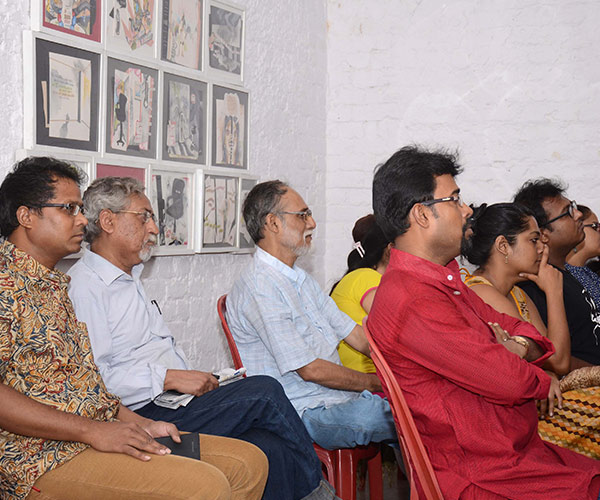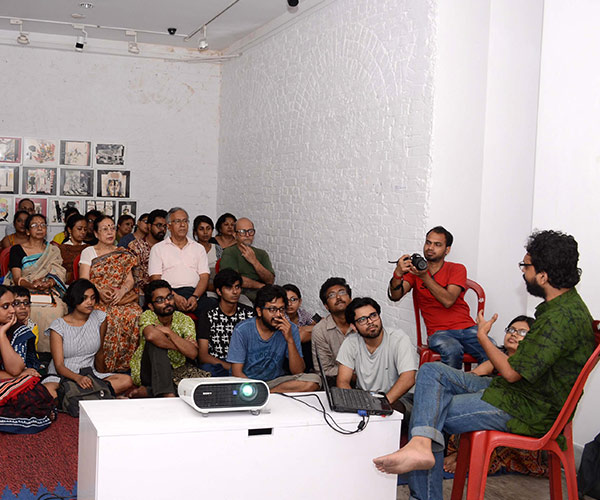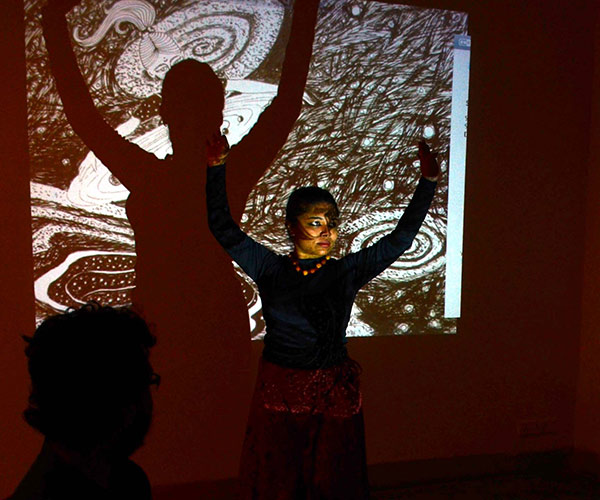Talks & Interactive Sessions
Talpatar Sepoy by Shri. Debdutta Gupta (Assistant Professor of Art History, St. Xaviers College Kolkata). Date: 28th September 2019.
Babu Putuler Itikotha by Shri. Debdutta Gupta (Assistant Professor of Art History, St. Xaviers College Kolkata). Date: 26th August 2018
Mukhosher Mukh by Shri Bijan Kumar Mondal (Curator and Secretary of Gurusaday Dutta Folk Museum Kolkata). Date: 4th June 2017
Chhau dance, is a semi classical Indian dance with martial, tribal and folk traditions, with origins in the proto-history of pre-Aryan eastern India. It is generally subdivided into three subtypes, the Purulia Chhau of West Bengal, the Seraikella Chhau of Jharkhand, and the Mayurbhanj Chhau of Odisha. The dance ranges from celebrating martial arts, acrobatics and athletics performed in festive themes of a folk dance, to a structured dance with religious themes found in Shaivism, Shaktism and Vaishnavism. The costumes vary between the styles, with Purulia and Serakeilla using masks to identify the character. The stories enacted by Chhau dancers include those from the Hindu epics the ‘Ramayana’ and the ‘Mahabharata’, the Puranas and other ancient & medieval Indian literature. Moreover in certain visual and performative aspects one can also find echoes of ancient animism and syncretic Buddhism. The dance is performed traditionally by troupes comprising solely men, regionally celebrated particularly during spring every year, and can be taken as a syncretic dance form that emerged from a fusion of classical Hindu dances and the traditions of ancient regional tribes. The dance brings together people from diverse socio-economic backgrounds in a festive and religious spirit. The knowledge of dance, music and mask-making is transmitted orally from one generation to the next. The two styles of Chhau dance that use masks (Purulia & Seraikella), blend within it forms of both dance and martial practices employing mock combat techniques (called khel), stylized gaits of birds and animals (called chalis and topkas) and movements based on the chores of village housewives (called uflis). Dating back to some 150 years, the tradition of making Chhau masks started during the rule of king Madan Mohan Singh Deo of Baghmundi. The masks used in the Chhau dance of Purulia are mainly for portraying mythological characters such as Mahishasur-Mardini, Rama-Sita, the fight of Rama and Rabana, etc. Sometimes small Santhal couple-masks are also used, thus furthering the idea of syncresis. The masks have feathers and other ornaments that surround the face, which can be extended 2 feet from the mask itself. Different colours are used to portray the various gods, goddesses, heroes, and demons. Made by artists from the Sutradhar community (from the ancient regions of Manbhum & Shikharbhum) the masks go through various stages. 8–10 layers of soft paper immersed in diluted resin-based glue are pasted layer by layer on the mould before the mud mould is dusted with fine ash-powder. The facial features are made from clay. A special layer of mud and cloth is applied and the masks are then sun-dried. After this, the mould is polished and a second round of sun drying is done before separating the layers of cloth and paper from the mould. After finishing and drilling of holes for the nose and eyes, the masks are coloured and decorated with organic materials created from plants and minerals. Under the mentorship of two traditional Chhau-mask-making artists, Bholanath Sutradhar & Taraknath Sutradhar, Chalchitra Academy organized the event “Chhau Mask-making workshop” at the Ganges Art Gallery, Kolkata, on June 4, 2017. Along with a large number of enthusiastic participants, some of the contemporary artists who took part in a creative & intellectual dialogue and practice with this age-old art-form were Mrinal Mandal, Sushanta Kumar Maharana, Pradip Rakshit, and Koustav Dey. The day reached its vivid fulfillment with an interactive session by the Curator & Secretary of the Gurusaday Museum, Shri Bijan Kumar Mondal.
Asimer Rupabhasya by Shri. Kaustabh Chakraboty. In collaboration with Ganges Art Gallery Kolkata. Date: 15th April 2016.
Art is perhaps the epitome of all things creative, all things expressive, all things meditative, and all things strung across a thread of passionate realisation. Oseemer Rupobhasyo, a multi-media exhibition-cum-workshop organised by Chalchitra Academy on the 15th of April, 2016, in the Ganges Art Gallery, was a brilliant effort of retouch the definitions and pulsations of art itself. Headed by the artists Mrinal Mandal & Jayati Banerjee, this event was nought but a curious experimentation where the trifecta of painting, music, and dance created a mesmerising diorama of philosophy and emotions. The aspects of Rupa and Bhashya were expressed by the artist Kaustav Chakraborty, the element of musicality was threaded together by the singers Karatoa Bhattacharya and Debarati Chakraborty, whereas an all-unifying palette of dance was provided by Lokeshwari Dasgupta. The audience were hypnotized to say the least and this, in a way, provided the foundation of an oath that Chalchitra Academy has thence taken to rejuvenate the dying canvas of soulful art in Bengal.



Origins of Bratakatha by Dr. Animesh Baidya (Indpendent Scholar), Date: 5th April 2015
Origins of Shellac Art by Shri. Saurav Jana (Assistant Professor of Painting, Burdwan University), Date: 13th June 2015
Lecture Session on the topic “Tracing the Influence of Traditional Art on Contemporary Art”. Invited Speakers: Prof. Partha Pratim Deb(Retired Dean, Rabindra Bharati), Shri Pradipta Bhatacharya (National Award winning Filmmaker), Shri Saurav Roy (Independent Researcher). Moderated by Prof. Sanjay Mukhopadhyay (Professor of Film Studies, Jadavpur University). Date:12th July 2015
On the rain-swept evening of July 12, 2015, Chalchitra Academy organised an one-of-a-kind interactive session at the Nandimukh Sabhagriha at Shahid Nagar, Kolkata. It pitted scholars, artists, film directors, art-writers, and art-enthusiats together in a lively cauldron of interaction where through discussions, lectures, narrations, and anecdotes, the participants as a whole tried to trace how and why the different forms, gharanas, eons, and subtypes of traditional lokaja and bhumija art-forms have influeneced the myriads of styles of contemporary art. Headed by the Secretary of Chalchitra Academy, the artist Mrinal Mandal, the event was moderated by the eminent critic Prof. Sanjoy Mukhopadhyay who passed the baton on to Prof. Partha Pratim Deb of Jadavpur University, who, in turn delineated the different establihed critical outlooks on the inter-dependance of traditional and contemporary art-forms. Then Pradipta Bhattacharya, the eminent art-house film director too up the mantel and narrated how he has used folk-songs in his films and how his philosophy has been influenced by traditional music. Then came Sourav Roy, the famous art-writer who gave his valuable tow-pence on the topic at hand. Capped by an extremely inquisitive and fruitful question-answer session, the day ended as a success in being able to ignite some very cogent queries in the hearts of each and every listener.
